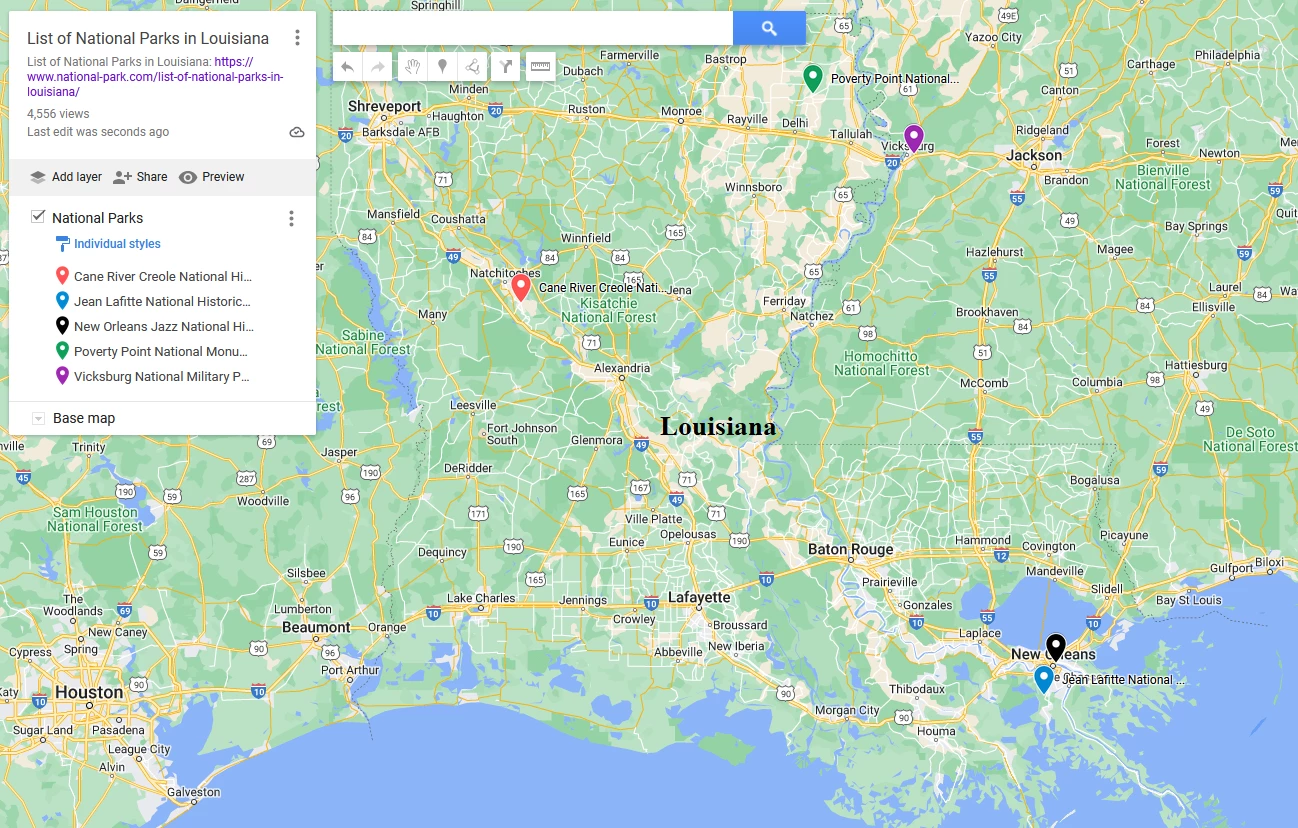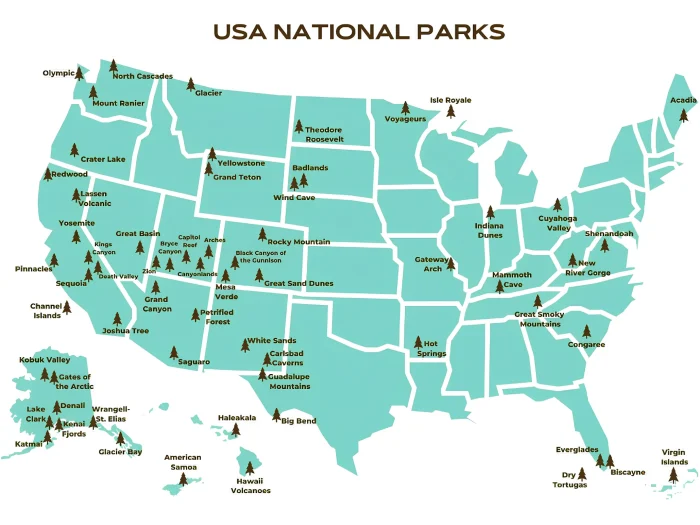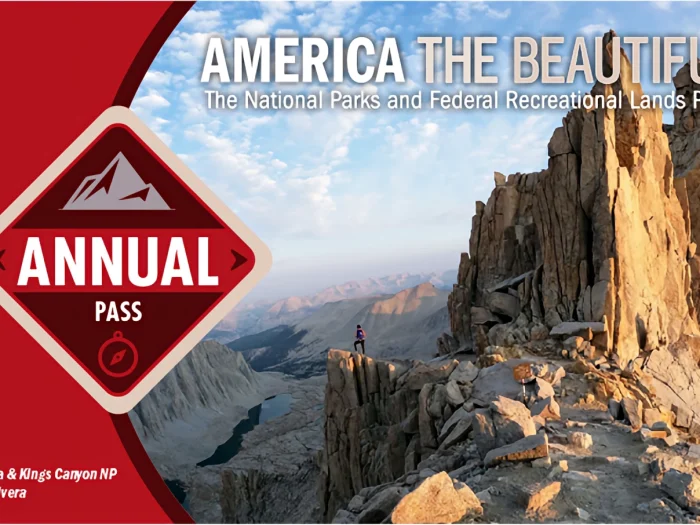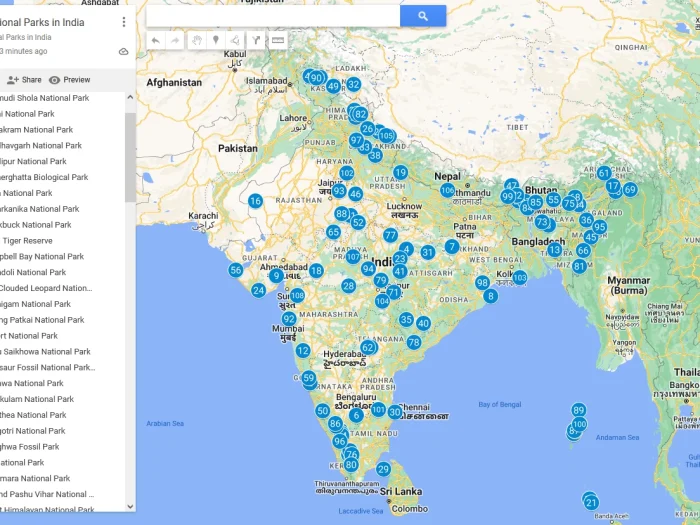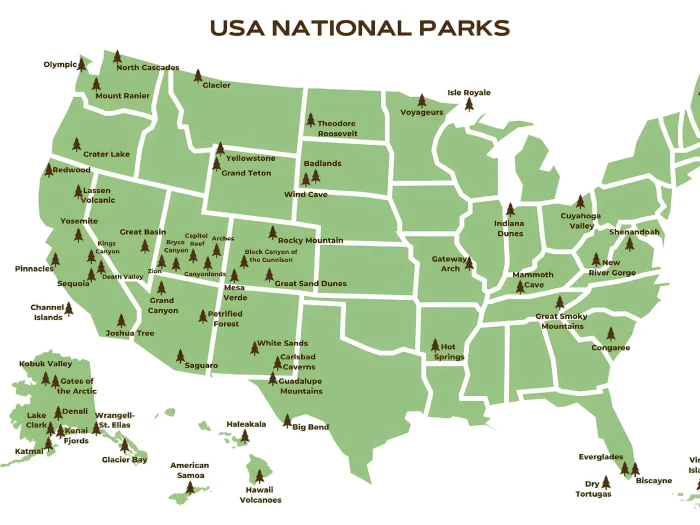List of National Parks in Louisiana
List of National Parks in Louisiana
Louisiana has 5 National Parks:
- Cane River Creole National Historical Park
- Jean Lafitte National Historical Park and Preserve
- New Orleans Jazz National Historical Park
- Poverty Point National Monument
- Vicksburg National Military Park
In this article I will write about these National Parks (infomation, things to do, weather). I also add Louisiana National Parks Map at the end of the article.
List of National Parks in Louisiana
1. Cane River Creole National Historical Park
Cane River Creole National Historical Park is located in Natchitoches Parish, Louisiana, and it preserves the cultural landscape of the Cane River region. The park encompasses several plantations and historic sites that offer visitors a glimpse into the Creole culture and history of the area.
Information:
- Address: 400 Rapides Dr, Natchitoches, LA 71457, United States
- Established: November 2, 1994
- Area: 84 ha
- Official website: https://www.nps.gov/cari/index.htm
- Phone: +1 318-352-0383
Things to do:
- Guided Tours: Join guided tours on Wednesdays through Sundays for both small and large groups. If guided tours aren’t your preference, self-guided and audio tours are also available.
- Plantation Buildings: Many plantation buildings are open for viewing, including the plantation store and tenant cabins. These structures are historically furnished to the 1960s era.
- NPS App: Enhance your visit by downloading the NPS App for offline use. It provides valuable information about both Oakland and Magnolia Plantations.
- Family-Friendly Activities: Participate in family-friendly activities and events within the park.
- Explore the Grounds: Wander through the plantation grounds, trails, and outbuildings.
- Visit the Park Bookstore: Discover a wide range of books, media, historical toys, Louisiana specialties, original artwork, and more.
- Picnic: Enjoy a picnic in one of the designated areas within the park while taking in the scenic surroundings.
Weather:
The weather of Cane River Creole National Historical Park is typically warm and humid, especially during the summer months.
- Summers are hot with temperatures often reaching the 90s°F (30s°C),
- Winters are mild with temperatures averaging in the 50s to 60s°F (10s to 20s°C).
2. Jean Lafitte National Historical Park and Preserve
Jean Lafitte National Historical Park and Preserve is a fascinating destination in southeastern Louisiana, preserving the rich cultural and natural heritage of the region.
Information:
- Address: Marrero, LA 70072, United States
- Established: March 4, 1907
- Area: 104.72 km2
- Official website: https://www.nps.gov/jela/index.htm
- Phone: +1 504-589-3882
Things to do:
- Virtual Experience: Explore the park from home with our video series, photo albums, and historical collections.
- Barataria Preserve Trails: Want to experience Louisiana’s wetlands? Walk the trails at the Barataria Preserve. It’s a great way to immerse yourself in the natural beauty of the area.
- French Quarter Visitor Center: Take a Carriageway History Stroll down the historic carriageway and discover what makes French Quarter architecture so unique. You can also collect Civil War Trading Cards offered at our sites.
- Discover Native Plants: Visit the French Quarter Visitor Center and explore the urban collection of native plants. Learn about the unique flora of the Louisiana delta.
- Visit Chalmette Battlefield: Explore the historic Chalmette Battlefield, site of the Battle of New Orleans during the War of 1812. Tour the battlefield, visit the Malus-Beauregard House, and pay your respects at the Chalmette National Cemetery.
- Experience Acadian Culture: Visit the Acadian Cultural Centers located in Lafayette, Eunice, and Thibodaux to learn about the Acadian (Cajun) culture of Louisiana through exhibits, demonstrations, music, and dance performances.
- Birdwatching and Wildlife Viewing: Bring your binoculars and camera for birdwatching and wildlife viewing opportunities. The park is home to a diverse array of bird species, including egrets, herons, ospreys, and more.
- Junior Ranger Program: Families with children can participate in the Junior Ranger program, where kids can complete activity booklets and earn badges while learning about the park’s natural and cultural resources.
- Picnic and Relax: Enjoy a leisurely picnic at one of the designated picnic areas within the park. Take in the scenic views, enjoy the peaceful surroundings, and appreciate the natural beauty of Louisiana’s landscapes.
Weather:
- Summer: Summers are hot and humid, with temperatures often reaching the 90s°F (30s°C) and high humidity levels.
- Winter: Winters are mild, with temperatures averaging in the 50s to 60s°F (10s to 20s°C).
- Rainfall: Rainfall is common throughout the year, with the wettest months typically occurring during the summer.
- Hurricanes: The region is susceptible to hurricanes, especially during the Atlantic hurricane season, which runs from June to November. Visitors should monitor weather forecasts and be prepared for changing weather conditions, especially during the summer months.
3. New Orleans Jazz National Historical Park
New Orleans Jazz National Historical Park celebrates the birthplace of jazz and the vibrant musical heritage of New Orleans.
Information:
- Address: 419 Decatur St, New Orleans, LA 70130, United States
- Established: October 31, 1994
- Area: 2 ha
- Official website: https://www.nps.gov/jazz/index.htm
- Phone: +1 504-589-4841
Things to do:
- Visit the New Orleans Jazz Museum: Explore the exhibits at the New Orleans Jazz Museum, housed in the historic Old U.S. Mint. Learn about the history of jazz through artifacts, interactive displays, and multimedia presentations.
- Attend Live Performances: Immerse yourself in the sounds of jazz by attending live performances at venues throughout the city. From traditional jazz clubs to outdoor festivals, there are plenty of opportunities to experience the music firsthand.
- Take a Jazz History Tour: Join guided tours or self-guided walks that explore the historic neighborhoods and landmarks associated with jazz in New Orleans. Learn about legendary musicians, iconic venues, and important events in jazz history.
- Participate in Workshops: Engage in workshops and educational programs offered by the park, where you can learn about jazz improvisation, music theory, instrument techniques, and more.
- Attend Special Events: Check the park’s calendar for special events, concerts, and festivals celebrating jazz and its cultural significance. These events often feature renowned musicians, guest speakers, and activities for all ages.
- Explore the French Quarter: Wander through the historic streets of the French Quarter, where jazz music fills the air and iconic jazz clubs line the bustling sidewalks. Experience the lively atmosphere and rich musical heritage of this vibrant neighborhood.
- Dine at Jazz-Inspired Restaurants: Enjoy a meal at one of the city’s many restaurants and eateries that pay homage to jazz culture. From historic jazz-themed establishments to modern dining venues with live music, you can savor delicious cuisine while soaking in the musical ambiance that defines New Orleans.
Weather:
- Summer: Summers are hot and humid, with temperatures often exceeding 90°F (32°C). Heat indices can make it feel even hotter, so staying hydrated and seeking shade is important.
- Winter: Winters are mild and comfortable, with temperatures typically ranging from the 50s to 60s°F (10s to 20s°C). Occasional cold fronts may bring cooler temperatures, but snow is extremely rare.
- Rainfall: New Orleans Jazz National Historical Park receives a fair amount of rainfall throughout the year, with the wettest months typically occurring from June to September. Afternoon thunderstorms are common during the summer months.
- Hurricanes: New Orleans Jazz National Historical Park is susceptible to hurricanes, especially during the Atlantic hurricane season from June to November. Visitors should monitor weather forecasts and be prepared for potential storms, especially during the late summer and early fall.
4. Poverty Point National Monument
Poverty Point National Monument is a UNESCO World Heritage Site located in northeastern Louisiana, USA
Information:
- Address: 6859 LA-577, Pioneer, LA 71266, United States
- Established: October 31, 1988
- Area: 3.686 km²
- Official website: https://www.nps.gov/popo/index.htm
- Phone: +1 318-926-5492
Things to do:
- Explore the Mounds: Take a self-guided or ranger-led tour to explore the six earthen mounds that make up Poverty Point. These mounds were constructed by the ancient inhabitants and offer insights into their ceremonial, residential, and possibly defensive purposes.
- Visitor Center Exhibits: Visit the visitor center to learn about the history and archaeology of Poverty Point through interactive exhibits, displays of artifacts, and educational videos. Gain an understanding of the daily life, technology, and culture of the ancient people who lived in the region.
- Take a Guided Tour: Join a guided tour led by a park ranger to learn more about the significance of Poverty Point and the archaeological findings discovered at the site. Rangers provide insights into the construction techniques, purpose, and cultural significance of the earthen mounds and ridges.
- Picnic and Nature Trails: Enjoy a picnic in the designated picnic area and take a leisurely stroll along the nature trails that wind through the park. These trails offer opportunities for birdwatching and wildlife viewing amidst the scenic landscapes of northeastern Louisiana.
- Visit the Interpretive Museum: Louisiana operates an interpretive museum at Poverty Point. Inside, you’ll find exhibits, artifacts, and educational displays that shed light on the rich history of this prehistoric culture.
- Picnic Amidst History: Enjoy a picnic in the park’s designated picnic areas. Imagine sitting amidst the remnants of an ancient civilization while surrounded by natural beauty.
- Visit Nearby Attractions: Explore other nearby attractions in the region, such as local museums, historic sites, and cultural landmarks. Learn more about the history and heritage of northeastern Louisiana while complementing your visit to Poverty Point National Monument.
- Learn About Conservation Efforts: Take the opportunity to learn about the conservation efforts aimed at preserving Poverty Point and its archaeological resources for future generations. Understand the importance of protecting this UNESCO World Heritage Site and supporting ongoing research and stewardship efforts.
Weather:
- Summer: Summers are hot and humid, with temperatures often reaching the 90s°F (30s°C) and high humidity levels. Visitors should dress accordingly and stay hydrated, especially if exploring the outdoor areas of the monument.
- Winter: Winters are mild, with temperatures averaging in the 50s to 60s°F (10s to 20s°C) during the day. Nights can be cooler, with temperatures occasionally dropping below freezing, but snowfall is rare.
- Spring and Fall: Spring and fall offer pleasant weather with mild temperatures and lower humidity compared to summer. These seasons are ideal for outdoor activities such as hiking and exploring the monument’s trails and archaeological sites.
5. Vicksburg National Military Park
Vicksburg National Military Park is located in Vicksburg, Mississippi, along the Mississippi River. The park preserves the site of the pivotal Civil War battle that took place from May 18 to July 4, 1863.
Information:
- Address: 3201 Clay St, Vicksburg, MS 39183, United States
- Established: February 21, 1899
- Area: 10.21 km²
- Official website: https://www.nps.gov/vick/index.htm
- Phone: +1 601-636-0583
Things to do:
- Take a Guided Tour: Join a ranger-led tour or battlefield hike to gain deeper insights into the history and significance of the Battle of Vicksburg. Rangers provide informative commentary and lead discussions about the events and individuals involved in the battle.
- Explore the Battlefield: Drive or walk through the battlefield to explore historic sites, monuments, and markers. Follow the driving tour route and stop at designated points of interest to learn about key events and battlefield features.
- Visit the USS Cairo Museum: Located within the park, the USS Cairo Museum preserves the remains of the Union ironclad gunboat USS Cairo, which was sunk during the Battle of Vicksburg. Visitors can view the recovered artifacts and learn about the history of naval warfare during the Civil War.
- Attend Ranger Programs: Check the park’s schedule for ranger programs, living history demonstrations, and special events that may be offered throughout the year. These programs provide interactive learning experiences and opportunities to engage with history.
- Picnic and Relax: Enjoy a picnic in one of the designated picnic areas within the park while taking in the scenic surroundings. Many picnic areas offer tables, shelters, and restroom facilities for visitors’ convenience.
Weather:
- Summer (June to August): Summers are hot and humid, with temperatures often reaching the 90s°F (30s°C) and high humidity levels. Heat indices can make it feel even hotter, so visitors should dress accordingly and stay hydrated.
- Fall (September to November): Fall brings milder temperatures and lower humidity levels, making it a pleasant time to visit the park. High temperatures range from the 70s to 80s°F (20s to 30s°C), while nighttime lows may dip into the 50s°F (10s°C).
- Winter (December to February): Winters are mild, with daytime temperatures averaging in the 50s to 60s°F (10s to 20s°C). Nighttime temperatures can drop into the 30s and 40s°F (around 0-10°C), but snowfall is rare.
- Spring (March to May): Spring brings warmer temperatures and occasional rainfall. High temperatures range from the 70s to 80s°F (20s to 30s°C), with increasing humidity as the season progresses. Visitors should be prepared for potential rain showers and thunderstorms during this time.
Conclude
Louisiana’s national parks offer a unique blend of natural beauty and rich history. From the bayous and swamps of Jean Lafitte National Historical Park to the vibrant cultural heritage preserved at Cane River Creole National Historical Park, visitors can explore diverse landscapes and learn about the region’s past. Whether you’re planning an adventure into nature or a historical tour, these parks provide memorable experiences. If you’re working on an essay related to similar topics, tools like the Persuasive Essay Writer can help shape strong, compelling arguments.
Tag: List of National Parks in Louisiana, Louisiana National Parks

